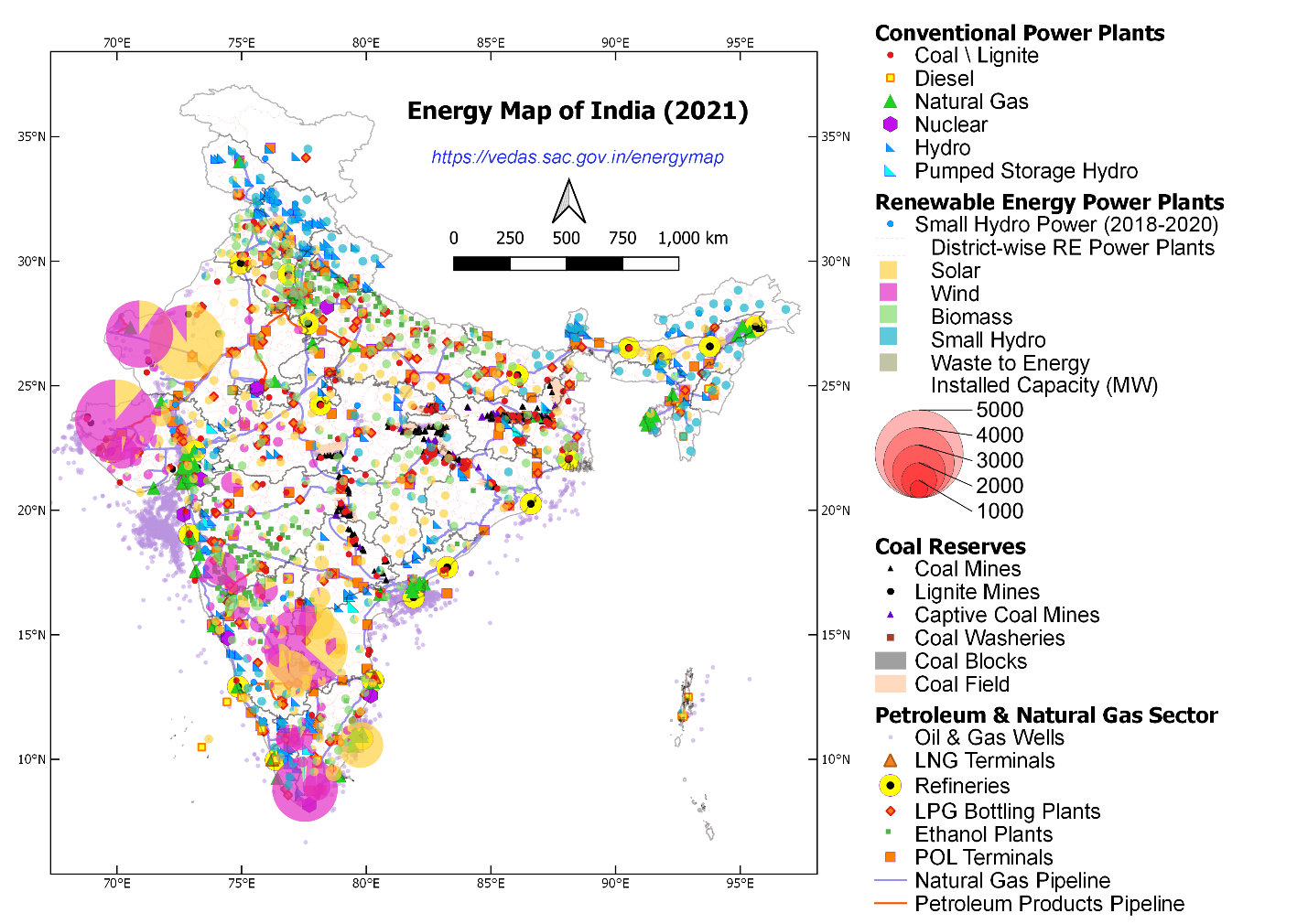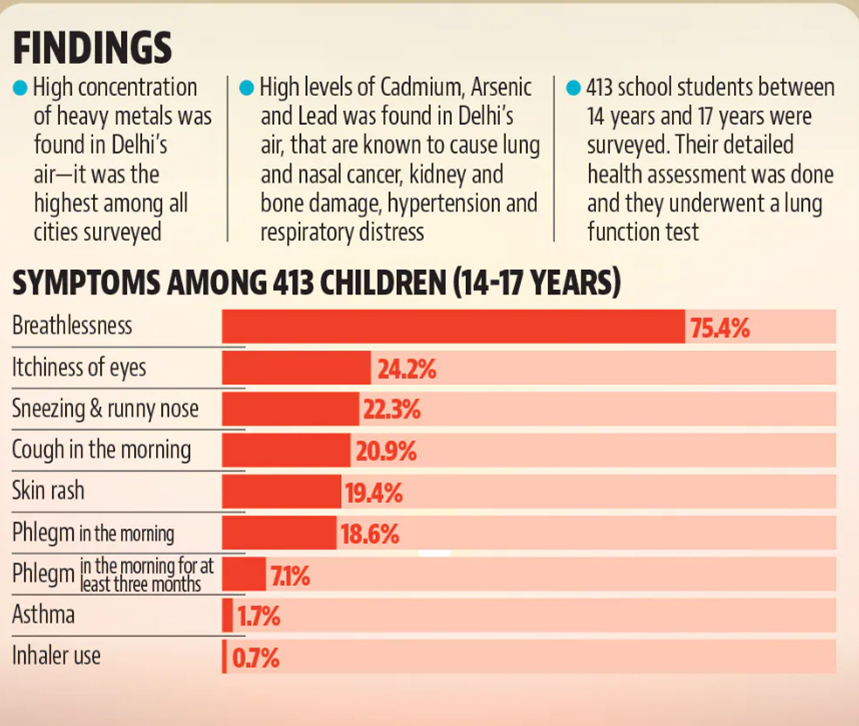Friday, 22nd October 2021
60-point action plan
In News
The government has prepared a comprehensive 60-point action plan that focuses on Single environment Act, birth certificate for citizenship and jobs clause in FTAs.
About the News
- According to the plan, government organisations need to create capacity for GIS-based planning and leveraging the potential of satellite-based imagery.
- This, the document states, may be taken up as a campaign under its mission, “Karamyogi”.
- More number of Chief Information Officers (CIOs) and Chief Technology Officers (CTOs) will be appointed for efficient use of data via Geographic Information System (GIS) mapping for decision making to increase the country’s GDP.
- The 60-point action is targeted at specific ministries and departments that fall broadly under three categories: (a) Leveraging IT and technology for governance (b) improving business climate and (c) upgrading the civil services.
About the 60-point Action Plan
- Leveraging IT and Technology for Governance
- To streamline disbursement of scholarships.
- To bridge the digital divide for underprivileged students by developing indigenous tablets and laptops and
- To digitize all land records by 2023 under the central database called ‘Matribhumi.’
- Improving Business Climate: In order to attract businesses the action plan aims at:
- Doing away completely with certain permissions and automatic notification of clearances.
- Reducing the cost of starting a business in 10 sectors and bringing it on a par with Vietnam and Indonesia.
- Providing incentives to states for timely land acquisition and forest clearances.
- Mentoring platform for start-ups and skilling programmes for emerging sectors.
- Providing single-point access to all government services.
- Upgrading the Civil Services:For this, the action plan intends to focus on capacity building that includes:
- Training of officers on various aspects of infrastructure in both the Centre and states.
- Infusion of expertise and exposure to latest technologies for higher civil services.
- Performance-based working.
- Institutional mechanisms for addressing issues of states and
- Restructuring of departments through government process re-engineering every 10 years.
Other Features of the Action Plan
- Citizenship linked to birth certificates: Citizenship has been planned to be linked to birth certificate through technology and mainstreamed as there has been no proof of citizenship in India so far.
- Environmental Conservation: There will be one comprehensive Environment Management Act that subsumes various laws in the sector for environmental protection and conservation.
- Housing and Poverty Alleviation: Niti Aayog is set to target poverty eradication within five years and the Ministry of Housing and Urban Affairs will plan residential facilities for service staff engaged in construction to prevent formation of slums. The Ministry of Social Justice and Empowerment has developed ‘family database design’ that would be promoted like Aadhaar.
- Miscellaneous: Department of Sports would adopt the Odisha model for promotion of sports at a national level, and the Department of Administrative Reforms and Public Grievances has been tasked with organizing all government circulars like the RBI’s Master Circulars. The Culture and Tourism ministries will identify and develop 100-200 iconic structures and sites.
Sources:
GRAP Measures
In News
Central Pollution Control Board (CPCB) enforced measures listed under the “moderate to poor” category under the Graded Response Action Plan (GRAP) in Delhi.
About the News
- CPCB has asked agencies to be ready to implement the measures under the ‘very poor’ category as the pollution rises.
- The GRAP measures are enforced on the recommendations by the Commission for Air Quality Management after reviewing the meteorological and air quality forecast.
- Till the year 2020, the Supreme Court-appointed EPCA used to order States to implement GRAP measures. The EPCA was dissolved and replaced by the Commission for Air Quality Management (CAQM) last year.
The Graded Response Action Plan (GRAP)
- About: The GRAP is a set of emergency measures to be taken to reduce air pollution, including odd-even vehicle rationing policy, depending on the level of pollution.
- Origins: The GRAP was notified by the Union Environment Ministry in 2017 to fight air pollution. It was approved by the Supreme Court in 2016.
- Planned Mechanism: It is a plan that institutionalized measures to be taken when air quality deteriorates. It created a step-by-step plan for the entire Delhi-NCR region and getting on board several agencies across the region.
- Under the “very poor” and “severe” category measures of the GRAP, diesel generators in the NCR are banned, except for emergency purposes among other measures.
- Accountability mechanism: GRAP fixes accountability and deadlines as each action to be taken under a particular air quality category, executing agencies are clearly marked.
- Air Quality Index: An Air Quality Index between zero and 50 is considered ‘good’, 51 and 100 ‘satisfactory’, 101 and 200 ‘moderate’, 201 and 300 ‘poor’, 301 and 400 ‘very poor’, and 401 and 500 ‘severe’.
- Reason for implementing GRAP: Air Pollution in Delhi is typical of the October-November period where farm fires in neighboring states and cooling weather typically combines covering the region with smoke.

Sources:
- GRAP Measures Come Into Force For ‘Poor’ To ‘Moderate’ Category
- GRAP measures for ‘moderate to poor’ called in ‘with immediate effect’ in Delhi
- Fight against pollution: Graded Response Action Plan to kick in with Covid crisis in air
- Explained: What is GRAP, Delhi-NCR’s action plan as air pollution increases?
BSF Powers and Jurisdiction
In News
The Ministry of Home Affairs (MHA) has modified the jurisdiction of the Border Security Force (BSF) in some of the Border States.
About the News
- The Changes: The Ministry of Home Affairs (MHA) has extended the jurisdiction of the Border Security Force (BSF) up to 50 km inside the international borders in Punjab, West Bengal and Assam. The BSF’s powers — which include arrest, search and seizure — were limited to up to 15 km in these states.
- The Ministry has reduced BSF’s area of operation in Gujarat from 80 km from the border to 50 km.
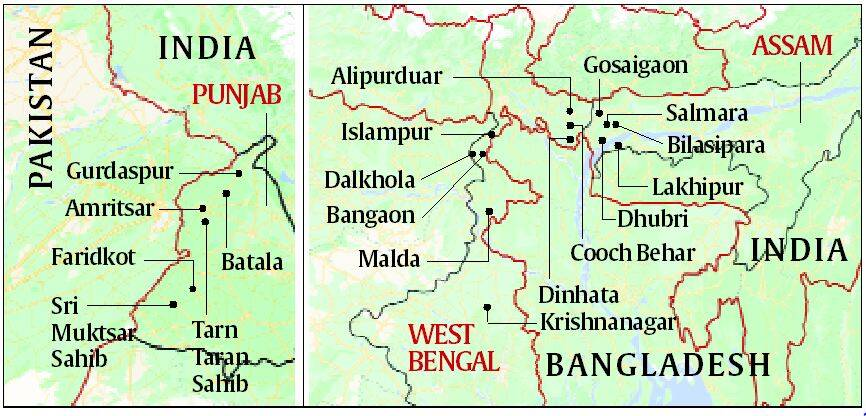
- Extended jurisdiction under certain laws: BSF’s jurisdiction has been extended only in respect of the powers it enjoys under Criminal Procedure Code (CrPC), Passport (Entry into India) Act, 1920 and the Passport Act, 1967. BSF currently has powers to arrest and search under these laws.
- It also has powers to arrest, search and seize under the NDPS Act, Arms Act, Customs Act and certain other laws. Its jurisdiction under these laws has not been changed.
- Reason for Changes: The objective of the move is to bring in uniformity and also to increase operational efficiency.
- The move was also necessitated due to increasing instances of drones dropping weapons and drugs in Jammu and Kashmir and Punjab.
- Impact on the powers of local police: Local police will continue to have jurisdiction over these areas.
- BSF cannot file chargesheets. They must hand over every arrested individual and every seized item to the state police or Customs.
About Border Security Force
- As a result of the recommendations of the Committee of Secretaries, the Border Security Force came into existence on 01st Dec 1965.
- At present BSF is holding 192 Regiments guarding International Border with Pakistan and Bangladesh. In addition, BSF is also performing Anti-Infiltration role in Kashmir Valley, Counter Insurgency in North East region, Anti Naxal Operations in Odisha and Chhattisgarh states and security of Integrated Check Posts along Pakistan and Bangladesh International Border.
- BSF is deployed at various ICP and LCS on Borders with Pakistan and Bangladesh.
- BSF contributes its personnel every year for UN Missions.
- BSF has sensitized people living in Border areas during Covid epidemic and provided necessary support/help under Civic Action Program.
Sources:
Energy Storage in Power Sector
In News
As part of India’s green energy push, the government is working on an Energy Storage policy for large scale integration of renewable energy with the country’s power system.
About the News
- The union power ministry has invited suggestions with regard to formulation of comprehensive policy framework and recommend other interventions to promote energy storage in power sector.
- The policy would broadly focus on regulatory, financial and taxation, demand management and technological aspects in order to speed up the implementation of storage capacity driven by the need to have increased flexibility in Indian power system to absorb the large scale integration of the renewable energy into the system during the coming years.
Need for Energy Storage
- Intermittent Renewable Energy Sources: Wind and solar resources are intermittent. Storage devices can provide frequency regulation to maintain the balance between the network's load and power generated, and they can achieve a more reliable power supply.
- Energy Storage off the Grid: For people living in areas that cannot access electricity grids, or for those who would prefer to be self-sufficient, battery energy storage is the best way to go.
- Hydro-power projects: There is a growing traction for hydropower projects among Indian clean energy majors. Large storages can help keep India’s power grids stable. The idea is to use cheap green power during off-peak hours to raise water to a height and then release it into a lower reservoir to generate electricity.
- Address the Supply-Demand mismatch: One of the distinctive characteristics of the electric power sector is that the amount of electricity that can be generated is relatively fixed over short periods of time, although demand for electricity fluctuates throughout the day.
- Electricity storage devices can manage the amount of power required to supply customers at times when need is greatest.
- Inefficient Power Production: Power utilities call upon the use of additional fossil fuel burning plants to ramp up or down as needed to provide for demand. However, plants operate more efficiently when running at full power. Here, Energy Storage can help efficiency of power plants.
What are Energy Storage systems and how can they be deployed?
- Pumped hydro: Pumped hydro involves pumping water uphill at times of low energy demand. The water is stored in a reservoir and, in periods of high demand, released through turbines to create electricity.
- Hydropower – including pumped storage – is expected to remain the world’s largest source of renewable electricity generation, according to the International Energy Agency.
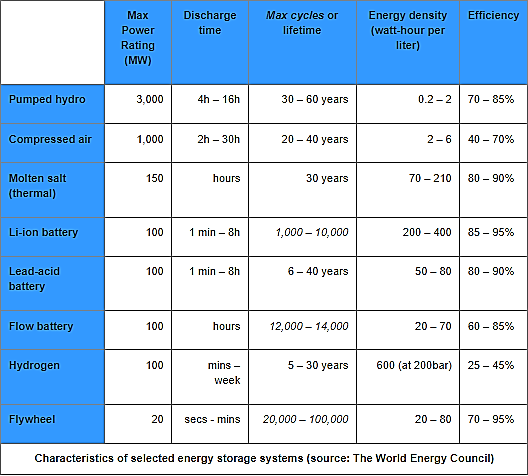
- Batteries: Batteries convert stored chemical energy into electrical energy. The world’s largest battery energy storage system so far is the Moss Landing Energy Storage Facility in California, US, where the first 300-megawatt lithium-ion battery – comprising 4,500 stacked battery racks – became operational in January 2021.
- Thermal energy storage: Thermal energy storage is used particularly in buildings and industrial processes. It involves storing excess energy – typically surplus energy from renewable sources, or waste heat – to be used later for heating, cooling or power generation.
- Liquids – such as water – or solid material - such as sand or rocks - can store thermal energy. Chemical reactions or changes in materials can also be used to store and release thermal energy.
- Water tanks in buildings are simple examples of thermal energy storage systems.
- Mechanical energy storage: Mechanical energy storage harnesses motion or gravity to store electricity. Compressed air energy storage is one of its variation, which involves storing pressurised air or gas and then heating and expanding it in a turbine to generate power when this is needed.
- Liquid Air: Charge by cooling and compressing air until it becomes a liquid. Store that in a tank. Discharge by letting it turn back into a gas and spin a turbine.
- Flow Batteries: This method circulates liquid electrolytes to charge or discharge electrons via redox reaction.
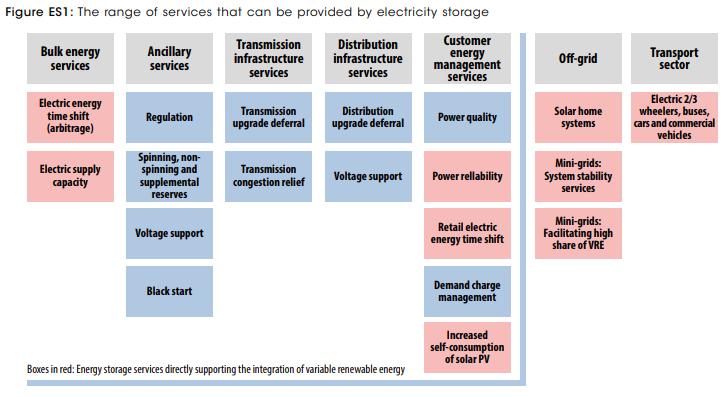
The challenges in energy storage in power sector
- Need for technological advancements: High shares of wind and solar PV power needs the storage systems to have high system flexibility, low energy costs and discharge rates, like pumped hydro systems, or new innovations to store electricity economically over longer periods.
- Lack of Policy Support: Storage remains an early-stage technology, present in only a few key markets and on policy support. Rules governing who should own and operate storage assets have long been a source of contention in electricity markets.
- At the core of the issue is whether storage can provide services to electricity grids, including transmission and distribution deferral, together with flexibility and balancing services in energy and capacity markets.
- Price of Storage Systems: Pinning down the cost of storage remains elusive. With the lack of commensurate technological advancements and policy support, the prices of these systems are to remain high for some time.
- Lack of Investment: market arrangements do not currently recognise the full value of storage and are therefore not delivering sufficient levels of private investment.
Way Forward
- Policy and Market Support: Accelerating market reforms that realise the full value and benefits of energy storage should be a priority. Government support for these projects remains critical while the cost of these solutions continues to decrease and the necessary market reform eventuates.
- Virtual power plants (VPPs): The integration of batteries into virtual power plants (VPPs) will play a crucial role in the renewable energy transition by providing better outcomes for consumers and supporting local and regional electricity grids.
- VPPs involve a network of distributed energy resources, including batteries, buying and selling energy in real-time to reduce electricity prices for participants and provide important services to the grid.
- Location of Production and Storage: A key driver of growth in energy storage has been the co-location of renewable energy production facilities with energy storage assets, which stabilises production and ensures firmer capacity during peak demand periods.
- India explicitly began rewarding this application in 2019 with a 1.2‑GW large-scale auction of solar-plus storage, mandating storage capacity for 50% of generation installed.
Question: Explain the need for developing energy storage systems for the power Sector? What are the various methods through which energy can be stored?
Sources:
- India working on an ‘Energy Storage’ policy
- Energy Storage
- Why is Energy Storage Such an Important Part of the Renewables Mix
- How can we store renewable energy? 4 technologies that can help
- 100% Renewables: Is Massive-Scale Energy Storage for Renewable Energy Possible?
- ENERGY STORAGE
- Electricity storage and renewables: Costs and markets to 2030
- Energy Storage
This Day in History - Battle of Buxar
On 22nd October, 1764, the Battle of Buxar was fought. After acquiring the royal charter in 1600, the British East India Company (EIC) started its expansionary policies in India. In 1755, Siraj ud-Daulah became Nawab of Bengal and tried to check the advance of British trading policies in Bengal. This led to the Battle of Plassey, where Siraj ud-Daula was defeated and a proxy ruler was instated as the Nawab of Bengal. The new Nawab Mir Qasim faced similar apprehensions as Siraj ud-Daula against the EIC and hence, formed an alliance with the Nawab of Awadh Shuja-ud-Daula; and the Mughal Emperor Shah Alam II. The combined forces of the alliance were decisively defeated by the army of the EIC led by Hector Munro. The battle resulted in the 1765 Treaty of Allahabad, in which the Mughal Emperor surrendered sovereignty of Bengal to the British. Shuja ud-Daula had to give up territories to the EIC with an additional war indemnity of 5 million rupees. Lord Robert Clive, the victor at the Plassey, became the first governor of Bengal.
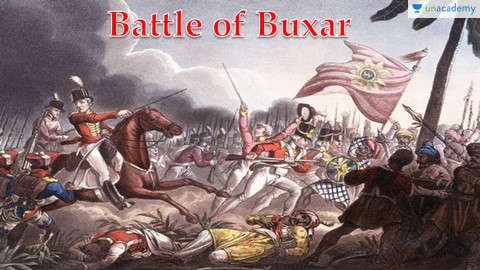
Source:
Image of the Day - 1 billion Covid-19 vaccine dose milestone
India crossed the 1 billion Covid-19 vaccine dose milestone on 21st October. India’s achievement is enormous. Perhaps nowhere else in the world have so many people been vaccinated so quickly. India also has to remain open to the possibility of providing booster doses from sometime next year. As of now, India looks all set to vaccinate about 70-80% of its adult population by the end of this year. India began vaccination only in mid-January, with a limited supply of vaccines that was put under further strain by the decision of the United States to clamp down on the export of raw materials. The shortage of vaccines was felt most acutely during the devastating second wave. But by that time, the group that received their vaccine in January and February might find its immunity waning. Eventually, it is the vaccines, and people’s behaviour, that will protect them against the disease. The 100-crore milestone is a reminder to strengthen our protection through continued adherence to Covid-appropriate behaviour, and to not fritter away the advantage.

Source:
Plant-based Jet Fuel
- Context: A recent study has noted that plant-based jet fuel could cut emissions by 68%.
- Brassica carinata is a species of flowering plant that is referred to as Ethiopian rapeseed or Ethiopian mustard. It is grown commercially on the Canadian prairie, in the southeastern US, the US northern plains and Uruguay.
- Jet fuel derived from this non-edible oilseed crop can replace the petroleum-based aviation fuel to reduce carbon emissions by up to 68%.
- Carinata-based SAF (sustainable aviation fuel) could help reduce the carbon footprint of the aviation sector while creating economic opportunities and improving the flow of ecosystem services.
- The price for producing SAF from carinata ranges from USD 0.12-1.28 per litre while the price for petroleum-based aviation fuel is USD 0.50 per litre.
- Since Carinata is grown in the 'off' season, it does not compete with other food crops, and it does not trigger food versus fuel issues. It also provides all the crop benefits related to water quality, soil health, biodiversity and pollination.

Sources:
- Indian-led team's plant-based jet fuel could cut emissions by 68%: Study
- Indian-Led Team's Plant-Based Jet Fuel Could Cut Emissions By 68%: Study
Image Source:
Blue Flag exercise 2021
- Context: Union Minister of External Affairs had visited Israel's Ovda Airbase to meet the Indian contingent participating in the Blue Flag exercise.
- The Blue Flag drill is a bi-annual exercise designed to strengthen Israel’s military cooperation internationally.
- It is organized by the Israeli Air Force and attended by air forces from around the world to strengthen cooperation between the nations.
- The 2021 exercise involves Air Force missions from eight countries that aims to share knowledge and combat experience to improve operational capabilities.
- 4th and 5th generation aircraft from Israel, France, Germany, Greece, India, Italy, UK and US will be taking part in Blue Flag 2021.
- India had earlier participated in the exercise in 2017 with the focus on boosting special operations capabilities, including search and rescue operations under different conditions and cross border counter-terrorist operations.

Sources:
Solidarity Trials
- Context: WHO has been considering solidarity trials for covid-19 vaccines.
- Solidarity Trial is a large, global randomized control trial designed to provide robust results on whether a drug can save lives in those hospitalized with severe or critical COVID-19.
- The aim of the solidarity trial for vaccines is to test vaccine efficacy across different geographies that could help speed up the regulatory process.
- It also ensures that vaccine makers have diversity in their trial participants that could help establish vaccine effectiveness across different ethnic and racial groups.
- This is modelled on the lines of a global solidarity trial for therapeutics.
- WHO had established a global solidarity trial for covid-19 therapies in 2020 across 52 countries to test the effectiveness of drugs such as Remdesevir, Interferon, hydroxychloroquine, and Lopindavir.
- The trials proved that these drugs had little or no impact on reducing mortality rates, duration of stay, and initiation of ventilation of hospitalized covid-19 patients.
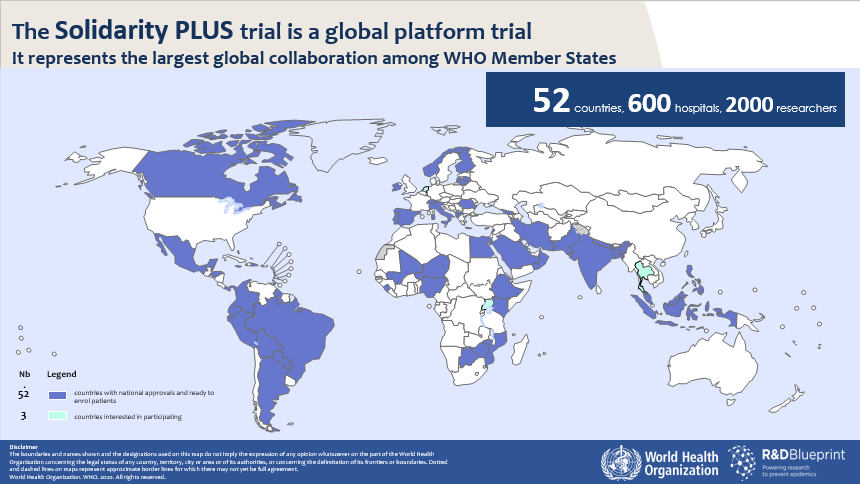
Sources:
Image Source:
Kushinagar international airport
- Context: The Kushinagar international airport was recently inaugurated.
- Kushinagar where Buddha attained Mahaparinirvana (ultimate salvation) in c. 483 BC, is among the most important Buddhist pilgrimages and is located in Uttar Pradesh.
- Today’s Kushinagar is identified with Kushinara, capital of the ancient Malla republic, which was one of the 16 mahajanapadas of the 6th-4th centuries BC.
- The area was a part of the kingdoms of the Mauryas, Shungas, Kushanas, Guptas, Harshavardhana, and the Palas. Kushinara is believed to have been inhabited until at least the 12th century.
- The first excavations in Kushinagar were carried out by Alexander Cunningham and Carlleyle, who unearthed the main stupa and the 6-metre-long statue of the Reclining Buddha in 1876.
- Kushinagar is among the very few places in India where the Buddha is depicted in reclining form.

Source:
Image Source:
Mitigating risks in infra finance: BL
Essence: The article stressed on need for thrust to new infrastructure projects for long term sustainability of growth and employment generation. The experience of funding large projects by Financial Institutions (FIs) reflects that asset quality deteriorates due to the lack of enterprise risk management among borrower community. This leads to rise in non-performing assets. At present banks have revamped risk management architecture by institutionalising proactive credit monitoring tools.
The article suggests that companies driving large infrastructure projects should also strengthen governance, risk and compliance built into its practices by removal of silos, sharing of information, committing to remove hurdles.
Why you should read this article?
- To know about the various initiatives of the government to promote infrastructure development.
- To understand about the risks in the implementation of infrastructure projects
- To understand the risk to commercial banks funding infrastructure projects.
- To know the status of the present risk management architecture for infrastructure projects and the way forward for better risk management.
Source:
International trade is not a zero-sum game: IE
Essence: The article draws the attention towards the growing level of protectionism being witnessed in India. A range of measure like being an highest initiator of anti-dumping measures to shield the domestic industry from import competition and recent amendment to the Customs Act, 1962 giving the government the power to ban the import or export of any good, reflect India’s protectionist measures.
It is high time for the government to realize that international trade is not a zero-sum game. India can’t maximize its interests at the expense of others. The government should however learn from the past where India has suffered by adopting protectionism measures.
Why you should read this article?
- To understand the measures taken by the government to protect its domestic industry.
- To understand how such measures can prove disastrous for the economy
Source:
The abiding relevance of integral humanism: HT
Essence: Article discusses how India has historically been the ‘land of ideas’ from the Vedic times, where philosophers, articulating profound ideas for human welfare in contrast to Europe, the mother of ideologies. The world passes through various phases of transition from time to time and after World War II in the last century a new world order began to take shape.
A new world order is taking shape today also, in the aftermath of the Covid pandemic. There are differing world views that can be taken forward at this juncture. The article has stressed on the ideology of a universal morality presented by the United Nations. This idea is superior to the interests of individual nations. Its foundation does not rest upon power or privilege; it rests upon faith.
Why should you read this article?
- To understand the difference between European ‘ideologies’ and Indian ‘ideas’.
- To understand how these ideologies and ideas shaped this world and once again how COVID pandemic is shaping a new world order.
- To under the idea of universal mortality, which is above nations.
Source:
Shanties turning into Food gardens
Background
- Nutrition has various forward and backward linkages, be in terms of income, gender, availability, social status.
- The ragpickers residing in their humble shanties around Delhi faced the issue of almost all the above factors.
- An environment NGO Chintan, worked up a plan to address this.
How Delhi shanties are turning in food gardens?
- An initiative was started by the NGO Chintan to educate the women of the locality regarding the importance of nutrition.
- They were provided with seeds for agriculture and techniques for good cultivation.
- This creates food security, especially for women, and also aids climate change mitigation.

Quote:
It's clear that agriculture, done right, is the best means the world has today to simultaneously tackle food security, poverty and environmental degradation. - Author: Irene Rosenfeld
Source:
Share the article
Get Latest Updates on Offers, Event dates, and free Mentorship sessions.

Get in touch with our Expert Academic Counsellors 👋
Frequently Asked Questions
UPSC Daily Current Affairs focuses on learning current events on a daily basis. An aspirant needs to study regular and updated information about current events, news, and relevant topics that are important for UPSC aspirants. It covers national and international affairs, government policies, socio-economic issues, science and technology advancements, and more.
UPSC Daily Current Affairs provides aspirants with a concise and comprehensive overview of the latest happenings and developments across various fields. It helps aspirants stay updated with current affairs and provides them with valuable insights and analysis, which are essential for answering questions in the UPSC examinations. It enhances their knowledge, analytical skills, and ability to connect current affairs with the UPSC syllabus.
UPSC Daily Current Affairs covers a wide range of topics, including politics, economics, science and technology, environment, social issues, governance, international relations, and more. It offers news summaries, in-depth analyses, editorials, opinion pieces, and relevant study materials. It also provides practice questions and quizzes to help aspirants test their understanding of current affairs.
Edukemy's UPSC Daily Current Affairs can be accessed through:
- UPSC Daily Current Affairs can be accessed through Current Affairs tab at the top of the Main Page of Edukemy.
- Edukemy Mobile app: The Daily Current Affairs can also be access through Edukemy Mobile App.
- Social media: Follow Edukemy’s official social media accounts or pages that provide UPSC Daily Current Affairs updates, including Facebook, Twitter, or Telegram channels.


